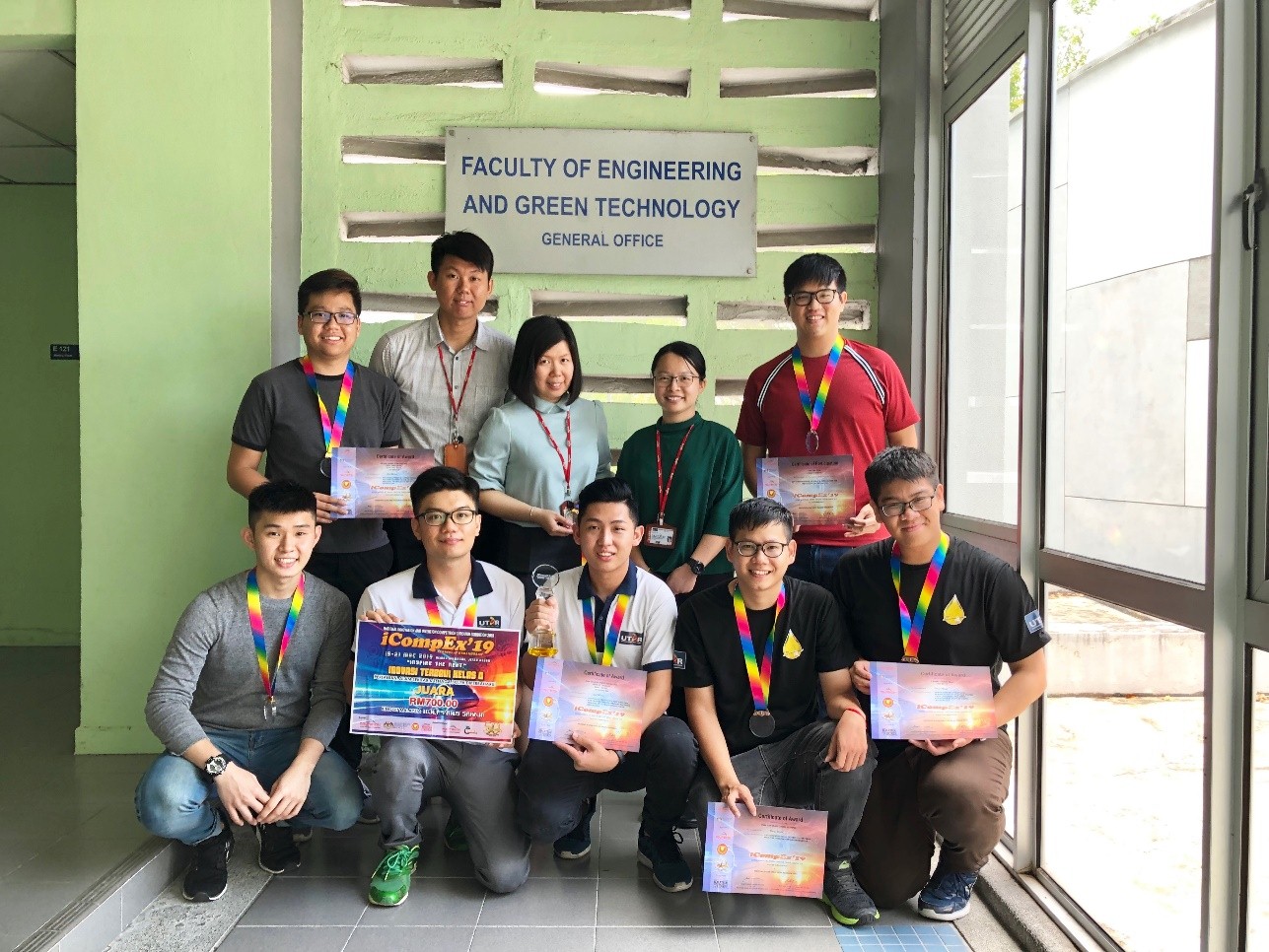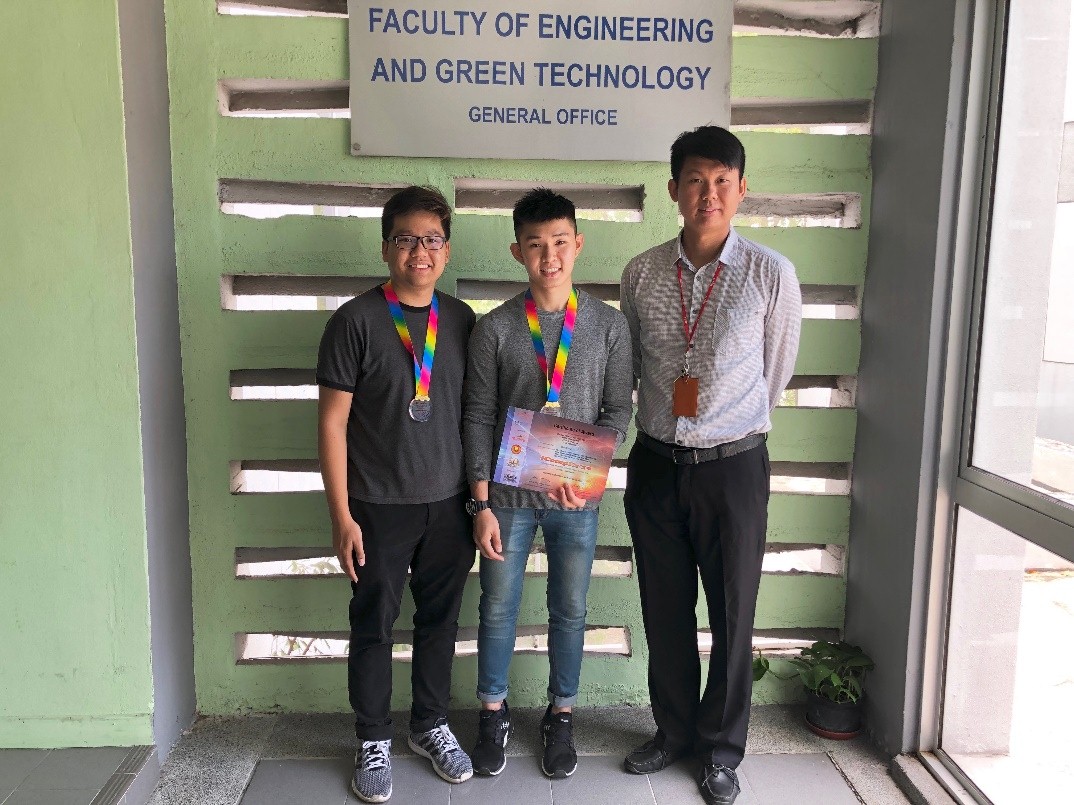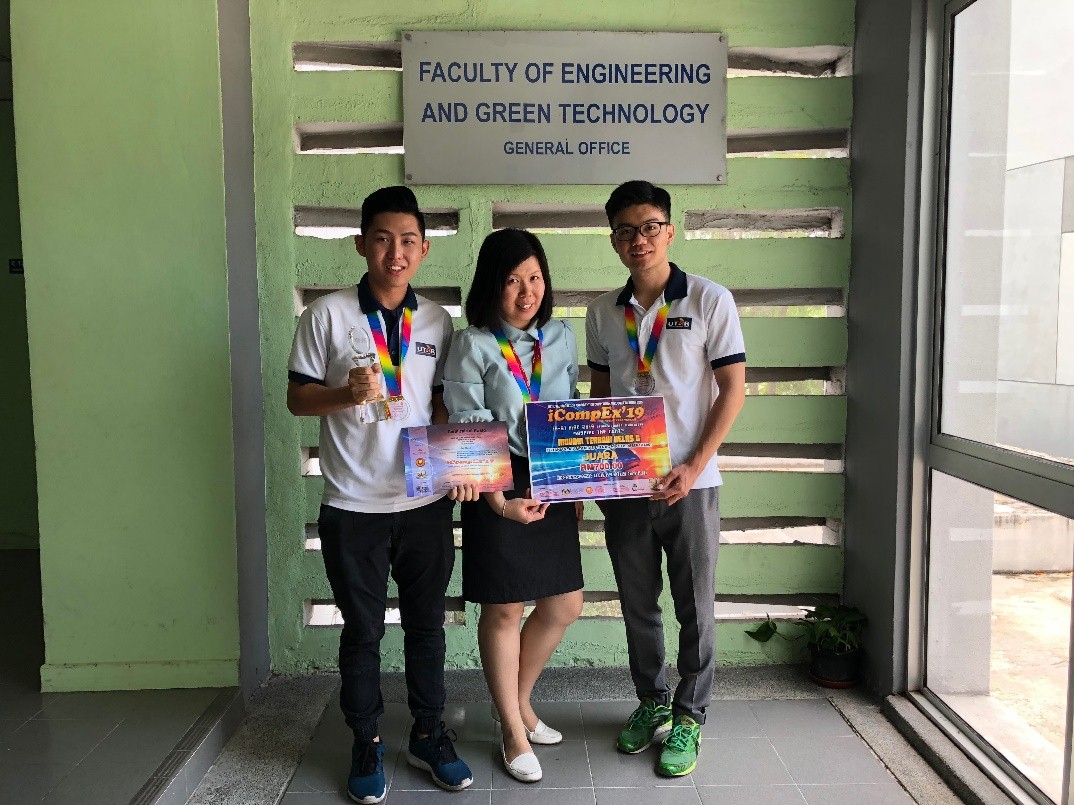


The four winning teams with their research supervisors
Four teams from the Faculty of Engineering and Green Technology (FEGT) won two gold and two bronze medals at the Innovation and Invention Competition through Exhibition 2019 (iCompEx’19), national level, organised by Politeknik Sultan Abdul Halim Mu’adzam Shah from 19 to 21 March 2019 at Dewan Wawasan, Jitra Kedah.
This is the fourth participation by students of FEGT in this competition, which is a competition and exhibition of innovation for new discovery. The competition also served as a platform for participants to highlight their research findings to the public.
The winning teams comprised of Bachelor of Engineering (Hons) Petrochemical Engineering students Chin Jian Yean and Cheng Yi Sheng in a team; Petrochemical Engineering student Chong Choon Keat; Petrochemical Engineering students Kuck Jinn Khean and Leow Guo Quan in a team; and Bachelor of Engineering (Hons) Environmental Engineering student Choong Man Kit and Petrochemical Engineering student Kong Zheng Ning in a team.
The teams participated in Category G: Agriculture, Environment & Renewable Energy. Chin with Cheng, and Chong won bronze medals and certificates, while Kuck with Leow, and Choong with Kong, won gold medals and certificates. Choong and Kong’s teams also won the “Best Innovation Project” in the same category, with a cash prize of RM700.
“Regardless of the prize we won, everyone is a winner because we all benefitted from this competition in various aspects. For me personally, I participated in this competition to promote the technology in wastewater treatment through photocatalytic technology,” said Kuck.
They added, “The technology we used to clean the wastewater is what made us stand out. The technology we used is quite advanced and new to most people. It does not only clean the wastewater, but is also able to produce biogas as an alternative source for fuel, which can be used for a variety of application, such as cooking.” The team also thanked their supervisor Dr Sin for all his guidance and support that secured their win at this competition. The team aimed to use their research to effectively clean palm oil mill effluent and also produce biogas as an alternative source of energy for the community.
Kuck and Leow’s research is titled “Advanced Photocatalytic Technology for Simultaneous Palm Oil Mill Effluent Degradation and Biogas Production”. This research is to design and develop the photocatalyst composites with desired characteristic and properties for effective photocatalytic activity, to study the photocatalytic performance of developed photocatalysis for degradaing POME and simultaneously producing biogas. Malaysia is one of the largest palm oil manufacturer in the worldwide. The generation of palm oil mill effluent (POME) alongside with the production of crude palm oil has created environmental issue for the palm oil mill industry in Malaysia due to its polluting characteristic. POME with its high organic content is a sources with great potential for biogas production. Biogas is a very important and valuable sources or fuel for the energy generation. Therefore, this research not only can solve the issue of environmental pollution. It also can recover the biogas from the system as renewable sources and provide an optimization method to the industry for future application.
“We are very honoured to win this award. We are indeed grateful to your supervisor Dr Lam Sze Mun for her guidance. She kept us motivated throughout the research process and helped us a lot. We were inspired by her and we are happy our hard work paid off. It is true when people say that passion and commitment towards the project will yield good results; and we won,” enthused Choong and Kong.
They also expressed their gratitude to UTAR for providing them the platform to acquire engineering knowledge. “The presentations in the classes were very helpful for us to enhance our skills and gave me confidence to present at the competition. We were also very lucky to have our course mates with us there to support us,” said Choong and Kong.
When asked of their motivation to participate in the competition, Choong and Kong said it was Dr Lam who encouraged them to participate. “She told us about this competition and advised us to participate. She said she regretted not having able to join the competition during her studies, and so she would want us to take up this challenge, and seize this opportunity to showcase our skills, talents, and research. It was a good experience travelling to Kedah, because we had to transport a large acrylic black box with a UV lamp inside, along with other equipment, all for the purpose to demonstrate our treatment process. What made us stood out, would be us coming prepared and feeling confident with our research. We presented together and gave the best possible answers to the judges,” explained Choong and Koong.
Choong and Kong’s research is titled “Innovative Photocatalytic Fuel Cell for Organic Wastewater and Bacteria Removal with Concomitant Power Generation”. The research showcases a photocatalytic fuel cell that uses photoelectrodes doped with catalyst, to treat wastewater (greywater) and generate electricity simultaneously. They also expressed their hope for their research to be successfully commercialised in China, as it is able to improve the environment by reducing wastewater and produce electricity.
Choong, who won a bronze medal, said that competition was an opportune avenue for him to learn more about engineering apart from the indoor lessons. “As a student, I personally believed that it is important for us to explore our talents and skills outside our comfort zone. We must challenge ourselves to try new things and discover new knowledge. Some of the sources may not come directly from the field of engineering. By learning outside my comfort zone, I understood how other fields are correlated to my field and what are the latest technologies and ideas from other fields that can help me in my research. One good way of learning is by interacting with other teams from other universities and by exchanging knowledge with them,” explained Choong.
He added, “I feel very happy and proud of myself because the hard work and time poured in for my research have paid off. I am also grateful to my supervisor Dr Toh Pey Yi for all the guidance, support, and encouragement provided. I am also thankful to be studying in UTAR, because it has provided me the platform for me to further my interest in engineering. I would also like to thank my parents for their understanding and for supporting me throughout this research, as well as my friends who have provided me assistance when I needed help. Although it is a bronze medal, I still learnt a lot and I received many ideas to improve my research for it to be able to well applied in the industry.”
Choong’s research is titled “Fertiliser Recovery and Purification of Surface Water that Contamindated with Fertiliser Runoff by using Microalgae”. His motivation to conduct the research was led by the increasing use of fertiliser in agriculture activities that had caused much water pollution during fertiliser runoff. By cultivating the microalgae named Chlorella vulgaris in the contaminated surface water, the Chlorella vulgaris will uptake the nutrients contain in the surface water which is cause by fertilizer runoff for their growth. During the growth of microalgae, it will remove the concentration of nutrients such as phosphate, ammoniacal nitrogen and nitrate in the water. After that, biomass will be harvested from the microalgae and directly can be used as organic fertilizer or process to produce biodiesel which can act as a substituent for fossil fuel like petroleum. The microalgae can then be applied in the wastewater treatment in the industry that produces effluent; causing pollution to the environment, such as synthetic fertilizer production industry or agricultural industry such as FELDA and plantation. Microalgae is promoted in the wastewater treatment as it is cheap, has high efficiency in nutrients removal, and able to reduce carbon footprint.
Chin’s aim of participating in the competition was to showcase his innovative ideas on treating the synthetic dye and simultaneously removing the carbon dioxide, which is a greenhouse gas that causes global warming. “What made my research stood out was the method I used, which was phycoremediation of treating synthetic dye that is more environmental friendly. Participating in the competition also gave me the chance to learn and understand other’s innovative research that will be useful in this Fourth Industrial Revolution, and that will improve the country’s economy,” said Chin.
Meanwhile, Chin’s team mate Cheng said that he learnt much from the competition, especially knowledge about other fields. “The competition is certainly not limited to the fields of engineering and I am glad I participated. I was able to apply my skills; speaking confidently in front of the crowd, use my critical thinking and logical thinking skills,” enthused Chin. Both of them also expressed their gratitude to their supervisor Dr Toh, and UTAR for the education they received that have led to their win in this competition.
Chin and Cheng’s research is titled “Phycoremediation of Dye in a Natural Way for Greenhouse Gas Mitigation”. Textile dyeing is ranked second as a fresh-water pollutant. About 17 to 20 % of industrial water pollution problem comes from the process of textile dyeing and finishing treatment given to fabric. Carbon dioxide is a greenhouse gases that causes global warming. In November 2018, the carbon dioxide emissions had increased to 410 ppm. Therefore, the research uses Chlorella vulgaris microalgae as a natural adsorbent to remove organic dye in wastewater and simultaneously absorbing carbon dioxide. Furthermore, phycoremediation method was found to be a green solution for dye contaminated wastewater treatment as well.

From left: Chong, Chin, Dr Toh, and Cheng

From left: Leow, Kuck and Dr Sin

From left: Choong, Dr Lam, and Kong
© 2019 UNIVERSITI TUNKU ABDUL RAHMAN DU012(A).
Wholly owned by UTAR Education Foundation Co. No. 578227-M LEGAL STATEMENT TERM OF USAGE PRIVACY NOTICE